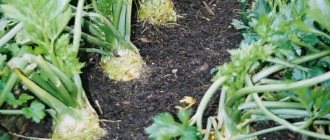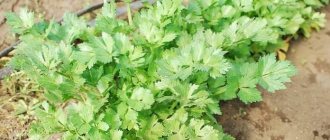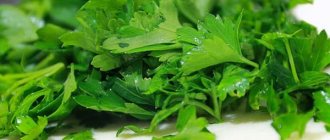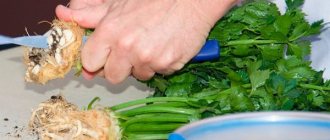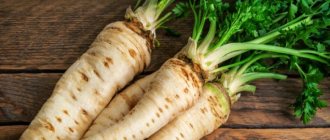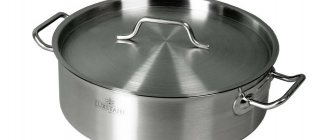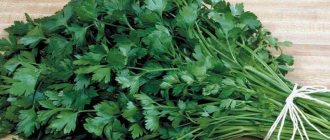Features of planting in the cold season
Planting parsley in the fall is practiced due to the fact that such plants produce an early harvest and are more resistant to all kinds of diseases. The root crops of this parsley are usually larger than those planted in the spring. And the harvest of greens often begins in March and early April.
Those who are concerned about the question of which variety of this crop is best to plant before winter in the Moscow region should pay attention to:
- Common leaf;
- Festival early;
- Delicate aroma.
The first of the varieties is characterized by exceptionally high productivity, while the second has early germination. Lovers of fragrant greens should pay attention to the latest variety.
But almost all varieties and varieties of parsley can easily overwinter in the climatic conditions of the Middle Zone.
What types of parsley are there?
Parsley is a biennial plant, meaning its seeds can only be obtained in the second year after sowing. This is a cold-resistant crop; with little shelter, it can produce crops even after frost. For successful cultivation, it is necessary to follow the watering regime and apply fertilizers correctly.
There are two types of parsley: leaf or curly and root. Often, novice gardeners are not aware of these features and can expect abundant greenery from root varieties.
You can understand the difference between leaf and root parsley using the table.
| Leaf parsley | Root parsley |
| The ground part is eaten | The underground part is used for food |
| Large rosette, about 80 leaves | Small rosette, no more than 40 leaves |
| Root small, many lateral shoots, inedible | The root is massive, edible, the lateral shoots are insignificant. |
| The leaf is soft, the taste is normal | The leaves are hard and have a pungent taste. |
There are also differences in agricultural technology. For example, both types need nutrients, but root parsley prefers phosphorus and potassium, while leaf parsley requires nitrogen in recommended dosages.
The leaf of curly parsley can be cut 2-3 times per season, but this should not be done when cultivating the root type of plant.
The best time to plant parsley before winter
The best time to sow parsley before winter, like other “winter” vegetables, completely depends on the region where the gardener lives. After all, the air temperature and the onset of winter are of primary importance. And it comes at different times: in the Far North it happens already at the end of September, October, and in Kuban - in December or January.
Sow parsley as late as possible, when stable but not yet severe frosts have set in. That is, the soil should be covered with the first crust of ice on top, but still be suitable for processing. In the Middle Zone, such weather phenomena are often observed in mid-November.
Negative temperatures during planting are observed only at night, but they are stable. Seeds are immersed in the soil when the daily minimum is -2/-3 degrees. Thanks to this, they will have time to swell before truly severe frosts set in, but will not sprout. If you sow too early, the greens will sprout, and frost will simply destroy the sprouts.
In regions where there is no stable transition of temperatures through zero, it is allowed to plant parsley at slightly positive temperatures. But then the sprouted plant will require cover in case of frost. But the family will be provided with fresh herbs almost all year round.
Landing in the ground
You can grow seedlings at home on a windowsill, and as soon as the ground thaws, plant them in open ground. This method is only suitable for leaf crops, but the root crop must be immediately sown in a permanent place, because the tap root cannot be transplanted from place to place in order for it to grow well.
At home on the windowsill at above-zero temperatures, seedlings will appear quickly, on the 5th – 6th day. After 1 - 1.5 weeks, a pair of true leaves will appear. After this, you can replant the plants - plant them in a garden bed or simply plant them less frequently in other pots at home.
Preparing seeds for planting in open ground
An important factor in obtaining a decent harvest of early spring greens is the correct preparation of seeds for sowing. Many gardeners fail simply because they simply throw planting material into the ground without subjecting it to any preliminary preparation. Experienced gardeners also remember well that pre-winter sowing requires a fairly large number of seeds, since the danger of falling out is greater.
Main stages of preparatory work:
- sorting;
- soaking and disinfection;
- vernalization or pelleting.
Each stage is equally important for success.
At the sorting stage, seeds are distributed based on their size and general appearance, and the presence of damage. Too little planting material may be too weak. At the same time, damaged seeds will rot and will not sprout. Autumn sowing requires special attention to the health of the material.
See also
How to use parsley for the face against age spots, the best recipes and rules of use
Read
Soaking, combined with disinfection, is carried out both to activate the swelling process and to increase the plant’s immunity. To prevent parsley from getting sick immediately after germination, it is soaked in a solution of potassium permanganate or boric acid. Copper sulfate is also used.
A modern method of achieving the same goal is sparging. This is the name of the process in which seeds are placed in warm water (temperature 20 degrees Celsius) and oxygen is pumped through a compressor.
Vernalization and pelleting are used to ensure uniform sowing and increase plant vigor. With the first method, the seeds are kept on ice until it evaporates in a wooden box, and with the second, they are covered with a mixture of fertilizers, humus and peat. It is important that each seed appears separately in such a substance.
Planting parsley and other important issues in growing greens
Parsley is the most common seasonal seasoning in our country. With its recognizable subtle aroma and mild taste, parsley can be an addition to any dish. It is impossible to imagine summer soups and salads without its greens, and due to the fact that it retains its fresh, attractive appearance for a long time, parsley sprigs are ideal for decorating sandwiches and salads. In addition, parsley is rich in vitamins and stimulates digestion. Growing parsley in your own garden is not too difficult. It belongs to biennial plants: in the first year, shoots appear from the seeds, a green rosette and an underground root crop are formed. In the second season, greenery emerges from the root crop and a straight arrow topped with an umbrella is formed. You can collect seeds from it for further sowing.
Parsley planting dates
There are several options for growing parsley. The first and most common option among summer residents is sowing in early spring, immediately after the frosts have gone (mid-March - early April). The second way is to sow the seeds before winter, at the end of October - beginning of November, with the approach of the first frost.
Parsley is a frost-resistant crop, the approaching cold will stop seed germination, shoots will appear in early spring and will delight you with fresh greens.
The third option involves conveyor sowing with a difference of 3-4 weeks until mid-August, in this case you will always have tender shoots of young plants. Another method is planting tubers; it is used not only to obtain seeds; from one tuber you can get a large harvest of greenery.
Growing parsley in a greenhouse
Both methods are suitable for growing in a greenhouse: sowing seeds and planting root crops. Before planting, the seeds are kept in a moist environment (between two layers of fabric) at room temperature for about five days. After the seeds hatch, they should be kept for another two days at a low temperature, about 2°C. This method of preparing seeds accelerates germination (seedlings can appear within a week after sowing in the ground) and increases yield. Forcing from root crops involves preliminary exposure of planting material at low temperatures in wet sand. Planted in prepared and watered furrows at an angle of about 45° and sprinkled with soil so that the top of the root crop remains open. The distance between the grooves is about 15 cm, the distance between the root crops is 6-7 cm. Growing parsley using the method of forcing from root crops gives a higher yield than from seeds by approximately 4 times. But the process is more labor-intensive, because you first need to get root vegetables.
Growing parsley in open ground
- Preparing seeds for sowing in open ground involves keeping and germinating them in a damp cloth for at least two days. In this way, an additional goal is pursued: you do not risk sowing and waiting for germination from substandard seeds. Seeds remain viable for 2-3 years.
- The preparation of the site for early spring sowing is carried out in the fall, together with the site for sowing before winter. The soil is dug up, humus or manure, sand, superphosphates, and potassium chloride are added. A certain amount of fertilizer is applied immediately before planting (ammonium nitrate, superphosphate).
- Parsley is sown to a depth of 1-2 cm, in grooves with a width of 15 cm; after the emergence of seedlings, it begins to be thinned out so that the distance is at least 6 cm. The soil should be loosened periodically; during the dry period, evening watering is required once a week.
- You can increase the yield of parsley by choosing the right site for it. The area where potatoes, cabbage or cucumbers previously grew is good for it, and the area left over from the beets will help increase the root crop.
- For sowing parsley for commercial purposes, you can use the forced germination method. To do this, carefully ground quicklime in a small amount is added to the furrow intended for sowing. The seeds, previously soaked in milk for several hours, are sown, sprinkled with water and the groove is filled with soil and compacted. Shoots may appear the very next day.
- Planting root crops is carried out in the same way as planting in a greenhouse. Preparation can begin 3-4 weeks before planting, at the end of February by placing the tubers in a box with wet sand. Root crops with sprouted greens must be planted very carefully, in well-watered and fertilized rows.
Care and cleaning
Parsley is not demanding on moisture; additional watering is required only during dry periods; watering can only be done in the evening. The distance between seedlings is left 4-5 cm; if you plan to grow root crops, then at least 6-7 cm. Loosening the soil after rain and watering is regularly required.
Harvesting parsley is possible in two ways: drying in a dry, dark place and freezing.
Both methods allow you to preserve all the valuable qualities, including the unique aroma of parsley. Parsley roots are quite tough, but they are also used as food. You can store it the same way as carrots, in a box with sand. Parsley is a frost-resistant crop and can withstand frosts down to -10°C. This makes it possible in the lower latitudes of our country to leave parsley tubers to overwinter under the snow, covering them with straw mats for insurance. This is how you can get the very first greens to your table.
MegaOgorod.com
How to choose the right place for autumn planting parsley
When choosing a place in the country to plant parsley before winter, the issue is approached carefully. Otherwise, the plant will not be able to overwinter, and the gardener will lose the harvest, even if he performs other agrotechnical procedures correctly.
Sowing parsley” width=”600″ height=”400″ />
The place for autumn planting of parsley is chosen so that it is not too windy and exposed to winter winds. This plant is sown where snow accumulates in winter, which will cover it and protect it from frost.
In addition to airtightness, factors such as proper lighting and location relative to groundwater are also taken into account. Parsley is one of those crops that do not like stagnant water, so choose beds that are not prone to moisture accumulation and to which groundwater does not come too close. Parsley grows well in sufficiently lit places.
Gardeners also take into account predecessors when sowing parsley. The best predecessor crops are those that ripen quite early. In particular, we are talking about potatoes, cucumbers and cabbage. Growing greens in beds where these vegetables grew is also good for soil health.
How to plant?
Seed preparation
Preparation of parsley seeds is necessary to eliminate low germination of low-quality and affected specimens.
A few days before planting, selected seeds are soaked in a one percent solution of potassium permanganate. It is enough to put them in a gauze bag for 20-30 minutes. Instead of potassium permanganate, solutions of boric acid or copper sulfate are used.
Bubbling, saturating the seed material with oxygen, will increase its resistance to diseases and pests.
More seeds are prepared for winter sowing than in spring. Therefore, procedures with them are carried out more often before planting.
Can't do without:
- vernalization, aging in ice;
- panning, enveloping in a mixture of humus, peat, mineral fertilizers;
- hardening with alternate placement in warm and cold water.
Having gone through all stages of preparation, the seeds will show resistance during wintering and will actively begin to germinate after warming up in the sun.
Selecting a location
After harvesting the vegetables from the garden, they begin to prepare a plot in the dacha for parsley. Vegetable crops need fertile soil with neutral acidity, although a slightly acidic option is also suitable.
A vegetable bed is prepared where groundwater does not come close to the surface. Otherwise, when the snow melts, the area will be flooded and the seeds may die.
In order for grass seeds to successfully overwinter, the bed must be in an open place with a lot of snow. For the spring harvest you need more sun than in the shaded corners of your summer cottage.
A place for planting parsley in the fall will be ideal if it has previously harvested potatoes, onions, tomatoes, and cabbage.
You need to know that after collecting the grass, it is better to sow the beds with greens. It is difficult for vegetables to grow after parsley.
Soil preparation
To plant greenery in the fall, you need soil in the selected bed:
- thoroughly cleanse of plant waste remaining from cultivated crops;
- loosen;
- nourish with organic and mineral fertilizers;
- moisturize well.
To prevent parsley from being attacked by pathogenic microorganisms or pest larvae during spring germination, all vegetation is raked from the area and destroyed..
Loosening the soil will allow you to cope with eggs and pupae of parasitic insects overwintering in the soil. You can pour boiling water or a solution of potassium permanganate over the area.
From organic fertilizers, compost or vermicompost is applied to the garden bed, up to 5 kilograms per 1 square meter. It is also necessary to feed with granules of superphosphate and potassium salt, 20 grams of each substance.
The same amount of fertilizer containing nitrogen is added. To improve the permeability of the soil, coarse river sand or fine-grained crushed stone is mixed into it.
The grooves for planting seeds are made in advance with a depth of 5 centimeters, covering them with film so that rain does not damage the integrity of the bed.
Landing instructions
Having chosen a suitable day for sowing parsley before winter, remove the film material. A thin layer of dry sand is poured into the grooves. They take a third more seeds than usual. This will avoid a lack of seedlings in April.
Having placed the seeds in the grooves, sprinkle dry soil, nutritious and loose, on top, and lightly compact them.
All that remains is to protect the plantings from frost and retain moisture and nutrients in the furrows. For this purpose, cover the bed with a layer of mulch consisting of peat, humus or chopped straw, and dry leaves.
If the weather is rainy, without reducing the air temperature, you can cover the beds with film. The material will save parsley from moisture getting into the soil and premature germination of seeds.
After the spring sun begins to heat up, the parsley seeds become active and grow, receiving enough moisture.
Preparing the soil for planting
The soil is well prepared before planting parsley. Preparing beds for sowing is a mandatory agrotechnical technique, without which it is impossible to obtain a harvest in principle. They also take into account which vegetables were grown to become green. After each crop, the soil requires enrichment with those substances that were especially heavily consumed by its predecessors.
The main agricultural practices that are used:
- loosening;
- soil fertilization;
- soil lightening;
- covering
Loosening is resorted to immediately after the previous crops are harvested. For this, standard hand gardening tools are used, since the area for sowing greenery is rarely very large.
Immediately after loosening the soil is fertilized with nitrogen and potassium fertilizers, superphosphates. Nitrogen fertilizers will be sufficient at the rate of 20 grams per square meter, and potassium salts and superphosphate - 15 grams per square meter.
After adding substances that replenish the deficiency of potassium, phosphorus and nitrogen in the soil, we begin to lighten it. To make the soil lighter, it is mixed with sand and peat. It is important not to overdo it, and also not to compact the soil.
Immediately before planting parsley, compost is added to the beds. Manure is undesirable for fertilizing greenery, and it warms the soil too much.
Do I need to soak dill and parsley seeds before planting?
ife
Dill already grows like a weed. I plant dry seeds. The main thing: buy ordinary varieties, do not be fooled by promises that something supernatural will grow. I used to like the Kibray variety, but in recent years they have been putting something else into the bags. A good variety “Alligator” does not go into baskets for a long time. And plant root parsley, it is 2 years old, and there are greens until late autumn.
A ksinya
No, don't.
Dill and parsley seeds can be planted without soaking.
I grow dill myself, after autumn harvest, the seeds fall off, in the spring you can see green, young dill.
Parsley also has the ability to grow, like dill; it can be planted in the fall, first covered with branches, but many prefer to plant in the spring, since there is a possibility that the parsley itself will freeze.
To plant parsley and dill, choose nutritious soil and, most importantly, water with warm water.
Although, as far as I know, parsley will produce a good harvest if planted in the autumn.
Dill and parsley are frost-resistant, so you can plant them without waiting for persistent heat.
Aleso
I never soak dill and parsley seeds; I only water the furrows with a warm, weak solution of potassium permanganate before sowing.
Everything grows in its own time, after the emergence of seedlings I begin to loosen, weed and water, and if it rains, then there is no need to water, the main thing is that it does not become overgrown with grass, everything must be weeded in time.
Andrey0817
Dill, parsley and carrots take a long time to sprout and many gardeners soak them for 3 days in warm water. Then they sprout 7 - 10 days earlier than those seeds that were not soaked, but there is more trouble with them because of these few days.
After all, it’s difficult to plant them wet - they stick to your fingers, but you need to dry them correctly - dry everything to a free-flowing state and you can’t overdry it.
MarinaSmv
No, you don’t need to soak dill and parsley seeds before planting - they need to be dried later, as they are too small. And besides, they germinate perfectly without soaking. As for whether it will rain or not - in spring and early summer the ground is usually wet - this is the first thing. Secondly, the beds are always watered before planting.
Irina0405
I don't think it's worth it. If you start soaking, then you definitely need good watering of the beds, otherwise they may not germinate and disappear. I just sow dry, since there is no watering, and I still need to wait for rain. And the seeds take a very long time to germinate.
angren
I don’t soak dill seeds before planting; they are sown on their own from last year’s dried dill inflorescences. But parsley has slow-germinating seeds, I soak them before sowing, placing them in a cloth, changing the water several times, then drying them on the same cloth until they become loose, such seeds are easier to sow, they are heavier and they sprout faster. During the season I sow dill several times with just dry seeds; bush dill does not outgrow for a long time.
Tashenka
Dill, in my opinion, grows well anyway. I always plant dill with dry seeds; it never even occurred to me to soak dill seeds. It even grows by self-sowing for me.
But you can soak parsley, because it takes a long time to sprout, although I don’t soak it either. I just plant both dill and parsley in one row so as not to lose the parsley while it sprouts, then I remove the dill, and the parsley continues to grow.
weber1201
This is not necessary, the main thing is that the soil in which dill or parsley needs to be sown is well prepared, as well as further proper care, especially watering, removing weeds, then there will be a good harvest of greenery, dill often grows in the same place next year, because it disperses well.
Sowing parsley seeds
Properly sowing parsley is quite simple. To do this, you just need to choose the right size of the plot and place the beds properly. Gardeners know well that this plant does not like deep planting, therefore, to organize the beds, they use tools that are usually used to loosen the soil, or even sticks.
See also
The best recipes for preparing parsley for the winter at home
Read
The average width of the plot is 1 meter. Often it is a rectangle with parameters of 1 meter by 2.5-3 meters. It is enough to dig up the soil on it to a depth of 10 centimeters. Any more depth simply doesn't make sense.
Furrows are made in the loosened area, the depth of which does not exceed five centimeters. Their bottom can be sprinkled with a thin layer of sand and a little compost or vermicompost can be added. Pre-prepared seeds are placed at a distance of 10 centimeters from each other. Having covered them with a layer of earth, they are additionally mulched with peat or again with compost.
When arranging the grooves, they also maintain a distance of 10 centimeters between them. This distance is considered the most favorable for the development of such a culture.
How to properly sow parsley before winter
The rules for underground sowing are quite universal, so if you learn to plant parsley in the fall and get good seedlings in the spring, you can grow other cold-resistant crops in this way.
Heat-loving plants do not plant before winter!
Choosing a location and preparing a bed for winter sowing
The bed for winter sowing of parsley must be prepared in advance (back in September) , while the soil is soft and amenable to cultivation, and not when it has already been set by frost.
Dig up the soil, add the necessary mineral and organic fertilizers (compost, humus).
Reference! Parsley grows well in loose and fertile soils rich in organic matter. If your soil is heavy and clayey, then you need to loosen it with sand.
Immediately cut grooves (at a distance of 15-20 cm from each other, 1.5-2 cm deep).
And then cover it with something so that they (the furrows) are not washed away by rain .
Important! Also prepare the soil in advance for filling the furrows. Alternatively, fill a bucket and place it in a country house or greenhouse. Or, just before sowing, buy soil for seedlings (literally 5-10 liters).
After what to plant: rules of crop rotation
The main rule of crop rotation is the alternation of crops on the site. In other words, it is not recommended to plant plants of the same family in one place several times in a row (especially tomatoes after potatoes and vice versa). Accordingly, parsley can be planted after any crops except the umbelliferous family , which include dill, parsnips, celery and carrots .
Preparing seeds for planting
As you know, the seeds of parsley (like other plants of the umbelliferous family) are covered with essential oils , which delay their hatching. Therefore, in order to speed up the germination of the seeds of umbrella crops, before spring planting they are processed, or rather, soaked in various solutions , thus washing out the essential oils.
However, if seeds are sown before winter, they do not require any pre-sowing preparation . Seeds are sown exclusively in dry and unprocessed form .
Advice! Sow straight from the pack!
Direct sowing
- Select a place for the garden bed in advance, prepare the soil, and cut furrows.
- When the ground freezes, sow the seeds in furrows 1.5-2 cm deep (No more!).
Important! In this case, you need to increase the sowing rate by about 25%, in other words, sow more densely than in spring . All weak seeds simply will not sprout in the spring.
- Sprinkle the seeds with loose soil prepared in advance (or purchased).
We repeat! Parsley seeds should not be buried more than 2 cm of soil.
- That's it, all that remains is to somehow designate the bed so that next spring you don't forget that this place is already occupied.
Note! No need to water!
Proper care of plants
After the parsley is sown, it is time to care for it. Plants must be protected from adverse weather conditions. They are constantly fed and watered when the time comes for green stems to appear.
Immediately after sowing the parsley, it happens that they decide to cover it. But this should only be done when the weather is both cold and snowless. Or when the plant sprouted from the ground in the middle of winter due to a prolonged thaw, which has recently happened quite often in the Middle Zone. When there is snow in winter, the crop is covered with it. This is done immediately after the white cover is established more or less permanently.
During the winter, parsley does not require watering or fertilizing. They begin to apply fertilizer when the weather is warm and the first shoots appear. The best help is compost, which is applied at the rate of 5 kilograms per square meter. It is important to immediately remove the first weeds and regularly loosen the soil. This culture loves light soil.
In addition to compost, a complex mixture of potassium fertilizers, superphosphates and nitrate is added to the beds. This feeding strengthens the immune system and stimulates the development of the aboveground part of the plant.
Water parsley several times a week. They take into account that this plant can even withstand drought, but if there is a lack of moisture, it becomes tough. Along with the hardness of the leaves, it accumulates aromatic substances. If a gardener needs tender greens, then he does not allow moisture deficiency, and if the aroma is important to him, then he radically reduces watering a week or two before harvesting.
Root parsley requires regular thinning. At the same time, those that are used as greens can grow quite densely.
Parsley - planting and care
It’s hard to imagine a summer diet without salads or other dishes with fresh herbs. Traditionally, you can find parsley on our tables. It is valued not only for its excellent taste and characteristic aroma, but also for its beneficial properties.
Parsley planting dates
You can sow parsley at several different times. Sowing parsley in spring can begin at the very beginning of April, as soon as the frosts have passed. Some prefer growing before winter from late October to early November. You can start sowing even in summer from the end of June to the beginning of July.
The time for planting parsley largely depends on the goals you are pursuing. I usually do summer sowing with the aim of selling it in early May for the next season. The fact is that summer sowing allows you to avoid a large amount of waste during storage.
If you want to please your family with lush greens as early as possible, planting before winter is suitable for you. At the same time, the work is complicated by weather conditions, so the beds are prepared about a month before planting and then the seeds are sown directly into the frozen soil. In winter, you can plant parsley as seedlings, as this will make it possible to plant ready-made bunches of greenery in the ground immediately after the onset of warm weather. This is done in February; ordinary pots are suitable as beds.
Sowing parsley in spring is the most popular option among summer residents and land owners. Here, the risk of seeds germinating during frosts is eliminated as much as possible, because then the crops will not be lost. You can plant parsley both in open ground and in a greenhouse.
Planting parsley in a greenhouse
Two methods are used: seed and forcing from root crops. Before planting parsley using seeds, they are soaked in damp gauze for at least five days. The temperature should be room temperature. As soon as the seeds germinate, they are kept for another ten days in damp gauze at a temperature of 2°C. This method gives a yield of up to one and a half kilograms per square meter, and the first shoots will appear within a week after planting.
Planting parsley by forcing it from a root crop and caring for it is a little more complicated. Root crops are also kept at a temperature of 2°C, but in sand. Next, they are planted in prepared furrows, pre-watered.
Prepared root vegetables should be placed at an angle of no more than 45° at a distance of approximately 6 cm. It is important that the head and neck remain uncovered with soil. 45 days after planting you will see the finished harvest. Although the process is more labor-intensive, you will be able to collect up to six kilograms of greenery from each square meter.
Planting parsley in the ground
Before planting parsley in the country, it is better to keep the seeds a little in a humid environment so that they hatch. Here you can proceed in exactly the same way as when preparing seeds for greenhouses. The area for sowing is also prepared in advance. To plant and care for parsley, you should prepare sandy soil with a high content of nutrients.
They begin work in the fall, when they do the digging. At the same time, humus or manure, superphosphates and potassium chloride are added. in spring
Be sure to add ammonium nitrate and superphosphate. Such preparation before planting parsley seeds will allow you to achieve good results and a bountiful harvest.
If you want to get a high-quality harvest, choose places in the garden where cabbage, cucumbers or potatoes previously grew. If you want to plant root parsley, choose a place where beets have previously grown. After the seedlings appear, they must be broken through at intervals of up to 4 cm. Always loosen the soil as soon as the rains have passed. Watering for parsley is not particularly important, but you can periodically water the beds in the evening.
womanadvice.ru
Harvesting
Harvesting parsley is very simple and occurs as needed. To do this, simply wait until the stems reach the required size and cut them off. They also consume greens from plants grown for their root crops. As noted earlier, to obtain tender leaves, the crop is watered abundantly, but for aroma, on the contrary, watering is reduced.
Root crops are harvested before winter. Although, if you leave them in the ground, then next spring they will produce greenery again, because parsley is a perennial.
You can store collected greens by freezing, drying or pickling in jars. Storing parsley root is similar to storing carrots - it is placed in a cool place in wooden boxes and sprinkled with dry sand.
Varieties and varieties
Leafy
This variety of parsley is grown for its fragrant and tender greens. Popular varieties:
- “Ordinary leaf” - forms a large rosette with a large number of dark green leaves (30–100 pieces), suitable for sowing before winter.
- "Breeze" is a frost-resistant variety. Greens are cut 80 days after germination. The rosette grows up to 75 cm in height.
- “Bogatyr” is a shade-tolerant variety with a late set of greenery. After cutting, it quickly grows a new one.
- "Astra" is an early variety with curly leaves. The green mass actively grows after cutting. Seeds can be sown before winter.
- “Esmeralda” is a curly-leaved variety with medium ripeness, forms a rosette with leaves on short petioles.
Root
This species uses roots and tops for food. It does not have many leaves, they are tougher and less aromatic compared to leafy greens.
If the leaves of root parsley are frequently torn off, the root stops growing. He remains frail and small.
Varieties:
- “Bordovikskaya” is a late-ripening variety with a cylindrical white root crop. The rosette has 28–30 dark green matte leaves.
- “Saharnaya” is an early ripening variety. The cone-shaped root vegetable of a grayish-white color is ready for consumption 95–100 days after the appearance of the first shoots. There are 20–40 leaves in the rosette. Not suitable for long-term storage.
- “Urozhaynaya” is a mid-season variety, ripeness occurs after 130 days. There are 11–20 leaves in a spreading leaf rosette. The length of the root crop is 20 cm, has good keeping quality.
How to care for parsley
If you sow parsley or dill often, you will have to thin them out several times. To form a good rosette, the distance between plants should be at least 10 cm in the garden bed, and at home on the windowsill or balcony you can leave 5 cm.
She loves moisture, so she needs to be watered, but do it in moderation - if the water stagnates, the plants will rot. It would be correct to arrange drip irrigation from the time the seedlings emerge from the seeds.
Oddly enough, it is easier to do this in the garden than at home - at home on the windowsill it is difficult to keep track of the level of humidity, so you will have to pay attention to dill and parsley every day. It is necessary to check and adjust soil moisture.
When a stem with three fully grown leaves appears, you can harvest. You need to cut off the outer stems close to the ground - this stimulates growth, the parsley will quickly grow green. Picking leaves from the tops will slow down growth.
During the summer, parsley produces 4 harvests. Parsley and dill have a spicy smell that insects do not like, you need to take advantage of this - grow them throughout the garden (if you can create optimal conditions). When growing them at home on the windowsill, you can not worry about flies and mosquitoes all summer.
Care
Until the first sprouts emerge above the ground, caring for and caring for parsley comes down to the gardener’s attentive attitude to watering and ventilation. Seedlings should be watered regularly as the soil dries, but not too much. Uninvited guests in the form of weeds should be removed at first detection.
In case of sudden severe frosts, the parsley can be covered with a special agronomic fiber that allows air to pass through well.
As soon as the first 2-3 true leaves appear, you can start weeding and thinning. Any manipulations must be carried out by the farmer carefully, taking care not to damage the fragile and vulnerable plant and its root system.
In order for parsley to form full-fledged leaf rosettes, it must be fed twice: when the first leaves appear and as soon as a full-fledged small rosette is formed. For these purposes, fertilizer is used, made from mullein or compost in a ratio of 9 liters of water per 1 kilogram of organic matter. It would not be superfluous to add 15 grams of potassium sulfate and superphosphate.
Timely watering, loosening, thinning and fertilizing parsley are excellent preventive measures for diseases of this plant. However, sometimes it can become infected:
- white spotting;
- brown rot;
- powdery mildew;
- peronosporosis;
- early burn;
- rust.
If any suspicious formations are detected on the plant, it must be processed. To do this, use a weak (1%) solution of Bordeaux mixture, which must be used to treat all the green parts of the parsley. Spraying with a 1% solution of colloidal sulfur helps rid the plant of powdery mildew especially effectively.
Spring chores
In addition to thinning in the spring, weeds are also destroyed and the soil is fertilized. It is better to use potassium or phosphorus for root parsley, and nitrogen fertilizers for leaf parsley. To get a good harvest, you need to feed it several times:
- the first - when young leaves appeared;
- the second – when the rosette began to form.
An excellent fertilizer is obtained from mullein or compost. It is dissolved in water in a ratio of 1 kg per 9 liters of water. Superphosphate or potassium sulfate (no more than 15 g) will not be superfluous in this composition.
It is important not to forget that parsley is often subject to various diseases and insect attacks. It is necessary to protect it from black or white rot and powdery mildew. It is advisable not to use strong chemicals, as this is harmful to health.
It is best to use so-called folk remedies or substances that are safer for humans. For example, parsley is often sprayed with Bordeaux mixture (no more than 1%). It is needed for most diseases. And a solution of colloidal sulfur (1%) copes well with powdery mildew. Soap compositions also help.
Harvest and storage
Parsley should be collected gradually: as it ripens and is needed. A rational attitude to collecting leaves and roots will provide the gardener with fresh and tasty aromatic greens for a long time.
Methods for storing parsley leaves may vary depending on your needs. For long-term preservation of the harvest, greens can be frozen or dried. And if you need the spice in the near future, then just put it in the refrigerator or prepare it in oil.
The roots of the plant should be stored in a wooden box and in a cool place. For better preservation, it is strongly recommended to cover them with sawdust or sand.
Possible mistakes
Not every variety of parsley is suitable for cultivation, so the choice of crop and supplier is approached responsibly. If you use low-quality seeds, the plant will be weak or not grow at all. Planting is carried out when the seeds swell, otherwise it will be too late. No work is done in rainy weather. In addition, sowing before sub-zero temperatures will cause early germination and then death of the plant. Seedlings are sown only when the soil freezes. Planting is not carried out on days prohibited by the Lunar calendar.
The bed is located away from groundwater flow. Before planting parsley seeds, the area is cleaned, removing any remaining grass, otherwise it will harbor insect larvae or microbes. Also, melted snow sometimes leads to flooding and death of the plant. After germination, parsley is watered with warm water no more than 3 times a week. Cold water will harm the plant, and insufficient watering will make the leaves rough and tough.
Important! The soil always contains peat, humus, and turf soil.
Planting parsley before winter will make it healthy and strong. Early sowing is a great way to get fragrant and tasty greens much faster. Before work at the dacha, pre-treatment of seeds and soil is carried out. Despite the fact that the plant is resistant to cold, it requires careful care, especially in the first days after planting in open ground.
Features of care
Caring for winter greens is not particularly difficult. As soon as the snow melts and the air warms up a little, the mulch should be removed from the garden bed and wait for the first shoots. Then the bed needs to be thinned out a little so that the young plants do not interfere with each other.
This is interesting: How to properly feed parsley for growth
Late frosts are usually not a problem for winter crops, but if the temperature drops to critical levels (short-term below –6°C or long-term below –3°C), the bed can be covered again with light-colored agrofibre or other breathable material. It is not necessary to make a frame at all.
If, despite all the efforts made, obvious “bald patches” are noticeable in the garden bed, fresh dill or parsley seeds can be sown in such areas, but in this case it is better to pre-germinate them by soaking them in water or growth stimulants.
When the warm weather finally sets in, caring for the green bed goes into the normal phase, common to winter and spring crops.
